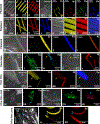Analysis of the elements and metals in multiple generations of electronic cigarette atomizers
- PMID: 31128425
- PMCID: PMC8283816
- DOI: 10.1016/j.envres.2019.05.014
Analysis of the elements and metals in multiple generations of electronic cigarette atomizers
Abstract
Background: Since their release in 2004, electronic cigarettes (ECs) and their atomizers have undergone significant evolution.
Objective: The purpose of this study was to evaluate and compare the elemental/metal composition of atomizers in cartomizer and tank style ECs produced over a 5-year period.
Methods: Popular cartomizer and tank models of ECs were dissected and photographed using a stereoscopic microscope, and elemental analysis of EC atomizers was done using scanning electron microscopy coupled with energy dispersive x-ray spectroscopy.
Results: Eight elements/metals were found in most products across and within brands purchased at different times. These included chromium, nickel, copper, silver, tin, silicon, aluminum, and zinc. Iron and lead were found in some but not all products, while manganese, cobalt, molybdenum, titanium, and tungsten were only found in a few of the products. The metals used in various components were often similar in cartomizer and tank models. Filaments were usually chromium and nickel (nichrome), although in some newer products, the filament also contained iron, copper, and manganese. The thick wire in earlier products was usually copper coated with silver, while in some newer products, the thick wire was predominantly nickel. In all products, the wick was silica, and sheaths, when present, were fiberglass (silicon, oxygen, calcium, aluminum, magnesium). Wire-to-wire joints were either brazed or clamped with brass (copper and zinc), and air-tube-to-thick wire joints, when present, were usually soldered with tin. Tank style products generally lacked a thick wire and sheaths.
Conclusion: In general, atomizer components in ECs were remarkably similar over time and between brands. Certain elements/metals were consistently found in most models from all generations, and these should be studied carefully to determine if their transfer to aerosols affects user's health and if their accumulation in trash affects the environment.
Keywords: Atomizers; E-cigarettes; Electronic cigarettes; Metals; Tobacco products.
Copyright © 2019 Elsevier Inc. All rights reserved.
Figures





Similar articles
-
Design features and elemental/metal analysis of the atomizers in pod-style electronic cigarettes.PLoS One. 2021 Mar 9;16(3):e0248127. doi: 10.1371/journal.pone.0248127. eCollection 2021. PLoS One. 2021. PMID: 33690644 Free PMC article.
-
Elements including metals in the atomizer and aerosol of disposable electronic cigarettes and electronic hookahs.PLoS One. 2017 Apr 17;12(4):e0175430. doi: 10.1371/journal.pone.0175430. eCollection 2017. PLoS One. 2017. PMID: 28414730 Free PMC article.
-
Design Features in Multiple Generations of Electronic Cigarette Atomizers.Int J Environ Res Public Health. 2019 Aug 14;16(16):2904. doi: 10.3390/ijerph16162904. Int J Environ Res Public Health. 2019. PMID: 31416115 Free PMC article.
-
Health Effects of Trace Metals in Electronic Cigarette Aerosols-a Systematic Review.Biol Trace Elem Res. 2019 Apr;188(2):295-315. doi: 10.1007/s12011-018-1423-x. Epub 2018 Jul 4. Biol Trace Elem Res. 2019. PMID: 29974385
-
A survey of metal carcinogenesis.Prog Exp Tumor Res. 1969;12:102-33. Prog Exp Tumor Res. 1969. PMID: 4905208 Review. No abstract available.
Cited by
-
E-cigarette fluids and aerosol residues cause oxidative stress and an inflammatory response in human keratinocytes and 3D skin models.Toxicol In Vitro. 2021 Dec;77:105234. doi: 10.1016/j.tiv.2021.105234. Epub 2021 Aug 17. Toxicol In Vitro. 2021. PMID: 34416289 Free PMC article.
-
Breaking the Myths Around e-Cigarettes: A Narrative Review Exploring the Impact of e-Cigarette on Human Health.Cureus. 2024 Oct 21;16(10):e72039. doi: 10.7759/cureus.72039. eCollection 2024 Oct. Cureus. 2024. PMID: 39569216 Free PMC article. Review.
-
Analytical methods for the identification of micro/nano metals in e-cigarette emission samples: a review.Chem Zvesti. 2021;75(12):6169-6180. doi: 10.1007/s11696-021-01779-5. Epub 2021 Aug 18. Chem Zvesti. 2021. PMID: 34421189 Free PMC article. Review.
-
The Impact of the Storage Conditions and Type of Clearomizers on the Increase of Heavy Metal Levels in Electronic Cigarette Liquids Retailed in Romania.Toxics. 2022 Mar 5;10(3):126. doi: 10.3390/toxics10030126. Toxics. 2022. PMID: 35324751 Free PMC article.
-
E-cigarettes and youth: an unresolved Public Health concern.Ital J Pediatr. 2022 Jun 14;48(1):97. doi: 10.1186/s13052-022-01286-7. Ital J Pediatr. 2022. PMID: 35701844 Free PMC article. Review.
References
-
- Lik H (2004) Flameless Electronic Atomizing Cigarette US20060196518A1.
-
- Williams M, Talbot P (2011) Variability among electronic cigarettes in the pressure drop, airflow rate, and aerosol production. Nicotine Tob Res. 13: 1276–1283. - PubMed
-
- Trtchounian A, Talbot P (2011) Electronic nicotine delivery systems: is there a need for regulation? Tob Control. 20: 47–52. - PubMed
-
- Grana R, Benowitz NL, Glantz SA (2013) Background Paper on E-cigarettes (Electronic Nicotine Delivery Systems). World Heal Organ Tob Free Initiat. Available: http://escholarship.org/uc/item/13p2b72n.
-
- Stratton K, Kwan LY, Eaton DL, Health P, Practice PH, et al. (2018) Public Health Consequences of E-Cigarettes. Available: https://www.nap.edu/catalog/24952.

